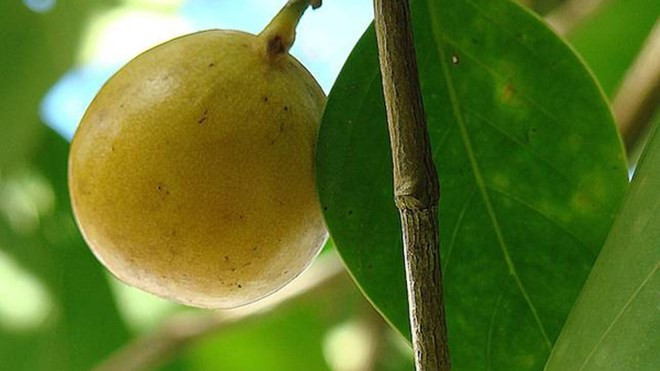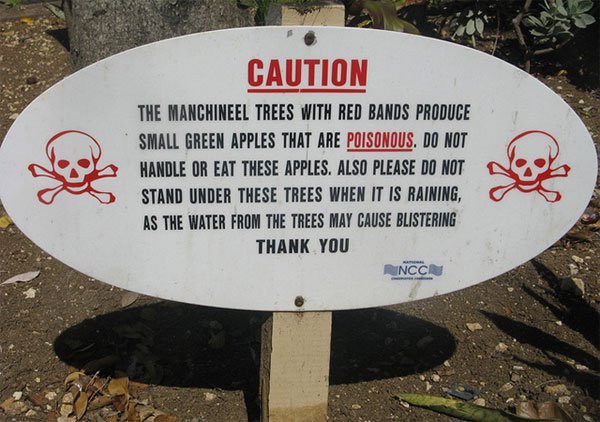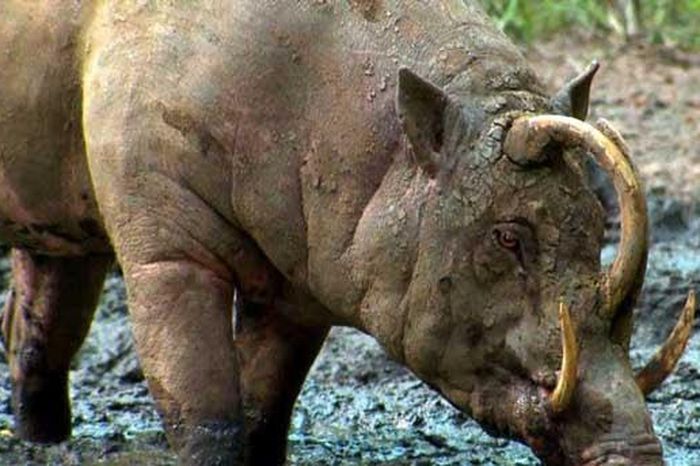Not only people but even animals do not dare to array to the unique tree species on this planet
Manchineel tree is also known as Hippomane mancinella, dubbed the "dead tree species" due to its kind of horrible toxin that makes people have to attach warning labels to stand away from trees 6m, do not eat fruit and avoid plastic species of the species This tree sticks to the skin.
The world's most exclusive species is found in the Caribbean and Bahamas of the United States, and is considered to be an effective barrier to this sea.

The Manchineel tree has a large canopy, reaching a height of 25m. Its fruit is round, apple-like, blue and when ripe turns red-yellow.
All parts of plants such as shells, leaves, plastic and fruits contain toxins. It is a mixed toxin consisting of hippomanin A and B and many other toxins not yet identified.
The plastic of the Manchineel tree is white and is extremely toxic. Just stick a drop of this plastic, the skin can be blisters, causing inflammation and burns. There have been many cases, passersby accidentally stood under the shade of trees and fell into the tree, causing severe burns.
The fruit of the Manchineel tree was dubbed the manzanita de la muerte, in Spanish, meaning " dead little apple ". Its appearance is quite similar to that of a coconut but only about 5 cm large. They have a sweet taste but if you eat it you will have stomach pain, vomiting, internal bleeding, gastrointestinal damage and possibly death. In addition, the fruit of this world's most poisonous plant can cause cancer, promoting the development of benign and malignant tumors.

Manchineel bark also contains toxins, if burning wood of this tree will cause temporary blind smoke.
It is because of these dangers that not only humans but also other organisms such as birds, squirrels and fruit animals must also stay away from the most terrible plants in this plant kingdom.
In 1521, against the Spanish invasion, the locals soaked Manchineel in the arrow, no one survived the poison.
Jonk, an English explorer who deliberately ate a ripe Manchineel. Immediately he had a burning mouth feeling like he wanted to burn, his limbs fell apart . and immediately the explorer was taken to an emergency.

Currently, scientists have yet to find a "rival" on the same level as the Manchineel in terms of the amount of toxins and the ability to "destroy" in the plant world.
Although it is a poisonous plant, if using the Machineel tree properly, it also offers certain benefits. With the ecosystem, Manchineel trees act as windbreakers and prevent natural erosion.
The poison of the Machineel plant is used in scientific research to create new breakthroughs such as finding safe pesticides or analgesics .
For hundreds of years, indigenous people in South America have carefully cut wood and dried Machineel trees in the sun to neutralize toxins. The fruit of the Manchineel tree when dried can make diuretics, pus flowing from the bark can cure edema.
Today, only the planned areas, away from residential areas, can grow Manchineel trees to avoid the risk of strong winds or big storms that can spread to people living nearby.
- The mystery of the "ghost tree" poisoning itself in exchange for nutrients
You should read it
- The oldest tree in the world 'old' 9550 years old
- Identify poisonous snakes in Vietnam
- The mystery of the 'ghost tree' poisoning itself in exchange for nutrients
- Birds have poison, can kill people just by touching the feathers
- How can eating poisonous mushrooms cause death?
- 11 species of lethal poisonous plants that we should avoid
- Beat losing, poisonous snakes rolled to death to deceive birds
- Fear of poisonous plants that corrode humans
May be interested
- Array (Array) in C / C ++
 c / c ++ programming language provides data structures called arrays, stored in a set of data of the same type with fixed length. an array is used to store data sets, but it is useful if you think of an array of variables with the same type.
c / c ++ programming language provides data structures called arrays, stored in a set of data of the same type with fixed length. an array is used to store data sets, but it is useful if you think of an array of variables with the same type. - 10 exotic tree species hold the world record
 these exotic plants possess interesting features such as height, longevity or fastest growing ability recorded in the guinness book of world records.
these exotic plants possess interesting features such as height, longevity or fastest growing ability recorded in the guinness book of world records. - Top strange animals become their own natural enemies
 the strangest animals on this planet have violated the natural laws of survival by killing themselves with the powerful weapons they possess.
the strangest animals on this planet have violated the natural laws of survival by killing themselves with the powerful weapons they possess. - Array (Array) in JavaScript
 array object - array helps you store multiple values in a single variable. it stores a set of fixed-size ranges of elements in the same type (type). an array is used to store a data set, but it is often more useful to think of an array as a collection of variables in the same type.
array object - array helps you store multiple values in a single variable. it stores a set of fixed-size ranges of elements in the same type (type). an array is used to store a data set, but it is often more useful to think of an array as a collection of variables in the same type. - Unexpected story: Wild dogs and foxes recognize the same species, frolic like brothers
 a man walking in a park in scotland has returned to the video of his dog carefree playing oddly with the wild fox. some people even believe that both animals think they are the same species.
a man walking in a park in scotland has returned to the video of his dog carefree playing oddly with the wild fox. some people even believe that both animals think they are the same species. - There are 50 venomous snakes, this is the most unique snake on the planet
 the venom of this frightening monster can kill 100 people at once.
the venom of this frightening monster can kill 100 people at once. - Introduction to 2D Array - 2-dimensional array in JavaScript
 in the following article, we will introduce and show you some basic operations to create and access 2-dimensional arrays - 2d array in javascript. essentially, a 2-dimensional array is a concept of a matrix of matrices - a matrix, used to store information. each 1 element contains 2 separate indexes: row (y) - column and column (x) - column.
in the following article, we will introduce and show you some basic operations to create and access 2-dimensional arrays - 2d array in javascript. essentially, a 2-dimensional array is a concept of a matrix of matrices - a matrix, used to store information. each 1 element contains 2 separate indexes: row (y) - column and column (x) - column. - Top 10 rare cat species in the world
 compared with stupid dogs, cats are considered to be more arrogant, lazier and more independent animals. although cats are one of the most popular pets, there are also species that are on the verge of extinction because of too few or too difficult to breed, and below are the species of cats lying in the wild. on this rare list.
compared with stupid dogs, cats are considered to be more arrogant, lazier and more independent animals. although cats are one of the most popular pets, there are also species that are on the verge of extinction because of too few or too difficult to breed, and below are the species of cats lying in the wild. on this rare list. - How many animals have ever existed on Earth?
 there are about 8 billion people living in the world, only a small fraction of the number of people who have ever existed, and this number is still very small compared to the number of animals that have ever lived on earth.
there are about 8 billion people living in the world, only a small fraction of the number of people who have ever existed, and this number is still very small compared to the number of animals that have ever lived on earth. - Strange species of plants grow yellow right in Vietnam
 in vietnam, people often plant a number of ornamental plants in the house with the meaning of bringing a wealth to the family such as: needle of the needle (money needle), perennial tree, sesame tree ... but yes a tree exists even in vietnam but does not grow money, but it emerges ... gold! it is an eucalyptus tree, also called a message.
in vietnam, people often plant a number of ornamental plants in the house with the meaning of bringing a wealth to the family such as: needle of the needle (money needle), perennial tree, sesame tree ... but yes a tree exists even in vietnam but does not grow money, but it emerges ... gold! it is an eucalyptus tree, also called a message.










 Pests can eat plastic, savior of man-made plastic waste
Pests can eat plastic, savior of man-made plastic waste Top 11 exotic animals you may have heard for the first time
Top 11 exotic animals you may have heard for the first time Unexpected story: Black bears are landing north of New York, not because of humans
Unexpected story: Black bears are landing north of New York, not because of humans Hot winds are weakening Antarctic ice sheets
Hot winds are weakening Antarctic ice sheets Science warning: When the climate gets hot, the ocean will become more toxic
Science warning: When the climate gets hot, the ocean will become more toxic Science warns: Sea levels may rise more than three meters in the future
Science warns: Sea levels may rise more than three meters in the future